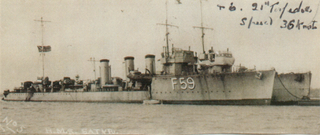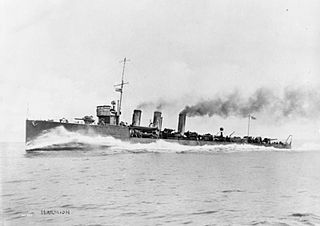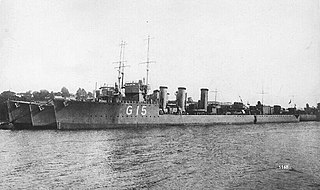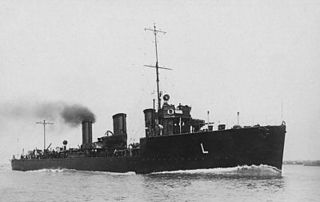
HMS Satyr was an R-class destroyer which served with the Royal Navy during the First World War. Launched on 27 December 1916, Satyr joined the Harwich Force under the command of Commander Hubert de Burgh. In 1917, the destroyer formed part of a force protecting the monitors Erebus and Terror in their bombardment of Ostend. As part of this action, Satyr, along with sister ships Taurus, Sharpshooter and Torrent, sank the German destroyer S20. After the war, the ship served with the Torpedo School at the Devonport. In 1923, the Navy decided to retire many of the older destroyers in preparation for the introduction of newer and larger vessels and Satyr was sold to be broken up on 16 December 1926.

HMS Tristram was a modified Admiralty R-class destroyer that served in the Royal Navy during the First World War. The Modified R class added attributes of the Yarrow Later M class to improve the capability of the ships to operate in bad weather. Launched in 1917, the destroyer was operational for just over four years. In 1917, Tristram joined the Grand Fleet and provided distant cover at the Second Battle of Heligoland Bight but did not engage with the enemy. After the armistice which ended the war, the destroyer was initially transferred to the Home Fleet before being placed in reserve in 1920 and then sold to be broken up in 1921.

HMS Ulster was a modified Admiralty R-class destroyer that served in the Royal Navy during the First World War. The Modified R class added attributes of the Yarrow Later M class to improve the capability of the ships to operate in bad weather. Launched on 10 October 1917, the vessel served with the Grand Fleet. After the war, the destroyer was placed initially in the Home Fleet, but then moved to the Reserve Fleet before, on 21 April 1928, being sold to be broken up.

HMS Sharpshooter was an R-class destroyer which served with the Royal Navy during World War I. Launched on 27 February 1917, the ship joined the Harwich Force, undertaking convoy escort duties. The vessel also took part in the Navy’s bombardment of Ostend later that year. On 1 June 1918, the destroyer rescued Captain A. C. Sharwood, one of the first pilots of the Royal Australian Navy, who ditched his Sopwith 2F.1 Camel nearby. After the war, Sharpshooter joined the Navy gunnery training establishment at Plymouth, but did not stay long and was reduced to Reduced Complement on 5 March 1919. The Royal Navy was rationalising its destroyer force and Sharpshooter, deemed superfluous, was sold to be broken up on 29 April 1927.

HMS Sarpedon was an R-class destroyer which served with the Royal Navy. The R class were a development of the preceding M-class, but differed in having geared turbines and other design changes. Launched in June 1916, the vessel escorted convoys that sailed between Scotland and Scandinavia in the First World War. After the war, the ship was allocated to local defence at Nore. However, in 1923, the Navy decided to retire many of the older vessels and Sarpedon was retired and was sold to be broken up on 23 June 1926.

HMS Nereus was a Admiralty M-class destroyer which served with the Royal Navy during the First World War. Launched in 1916, the vessel served with the Grand Fleet until the end of the conflict. The vessel operated as part for Thirteenth Destroyer Flotilla in support of convoy operations. In 1918, the flotilla took part in one of the last sorties of the war, although the British and German fleets did not meet and the destroyer returned without seeing any action. After the conflict, the destroyer was worn out by the demands of high speed operation in poor weather. Nereus was decommissioned and sold to be broken up in 1921 after less than six years service.

HMS Rigorous was an R-class destroyer which served with the Royal Navy during World War I. Launched on 30 September 1916, the vessel operated as part of the Grand Fleet, operating as part of destroyer flotillas hunting German ships that were attacking convoys. One flotilla was successful in destroying a Q ship in 1917. After the War, the destroyer was given a reduced complement and was sold to be broken up on 5 November 1926.

HMS Rowena was an R-class destroyer which served with the Royal Navy during World War I. Launched on 1 July 1916, the ship operated as part of the Grand Fleet as part of a destroyer flotilla hunting for German vessels that were attacking convoys in the North Sea. Although there were many reported sightings, no submarines were sunk. After the conflict, the vessel was transferred to the Navy’s establishment at Portland to help in the development of anti-submarine warfare, which ultimately helped in the Battle of the Atlantic. Rowena did not, however, see the fruit of this labour. After twenty years of service, the destroyer was retired and sold to be broken up on 27 January 1937.

HMS Romola was an R-class destroyer which served with the Royal Navy during World War I. Launched on 14 May 1916, the ship operated as part of the Grand Fleet, operating as part of a destroyer flotilla. The ship sailed to intercept the German High Seas Fleet in what would be one of the last major expeditions of their Navy in the war but saw no action. After the conflict, the destroyer was held in reserve until being retired and sold to be broken up on 13 March 1930.

HMS Lochinvar was a repeat Laforey-class destroyer which served with the Royal Navy during the First World War. Named after the character in the poem Marmion, the ship was originally to be called HMS Malice but was renamed prior to being launched on 9 October 1915. The destroyer joined the Harwich Force and took part in anti-submarine patrols, as well as escorting the monitors Erebus and Terror for their attacks on the canal gates at Zeebrugge and the port of Ostend in 1917. After the Armistice, the vessel was placed in reserve and sold to be broken up on 25 November 1921.

HMS Tactician was an S-class destroyer, which served with the Royal Navy. Launched on 7 August 1918, the vessel entered service at the closing of the First World War. The ship joined the Fourteenth Destroyer Flotilla of the Grand Fleet but was placed in Reserve at Nore in 1919. Tactician deteriorated over the following years and was sold to be broken up on 5 February 1931 following the signing of the London Naval Treaty that limited the amount of destroyer tonnage that the Navy could retain.

HMS Tara was an S-class destroyer, which served with the Royal Navy. Launched on 7 August 1918, the vessel entered service at the closing of the First World War. The ship joined the Fourteenth Destroyer Flotilla of the Grand Fleet but was placed in Reserve at Nore in 1919. Tara deteriorated over the following years and was sold to be broken up on 17 December 1931 after the signing of the London Naval Treaty that limited the amount of destroyer tonnage the Navy could retain.

HMS Pellew was a Admiralty M-class destroyer which served with the Royal Navy during the First World War. The M class were an improvement on the preceding L class, capable of higher speed. Launched on 18 April 1916, the vessel served with the Grand Fleet escorting convoys. The vessel was part of an unsuccessful attempt by the navy to trap the German submarines that had taken such a heavy toll on merchant shipping in December 1917. The action involved an eight-ship convoy consisting of four merchant vessels escorted by two armed trawlers and the sister ships Pellew and Partridge. Instead of submarines, four German destroyers attacked, sinking all but one member of the convoy and disappearing before the light cruisers which were to be the spring in the trap could arrive. Pellew, the sole survivor, took refuge in a Norwegian fjord. After the armistice that ended the war, the destroyer was placed in reserve and subsequently sold to be broken up on 9 May 1921.

HMS Pelican was a Admiralty M-class destroyer which served with the Royal Navy during the First World War. The M class were an improvement on the preceding L class, capable of higher speed. Launched on 18 March 1916, the vessel served with the Grand Fleet, taking part in significant actions on 19 August 1916 and 4 May 1917, as well as the fight between the British and German battlecruisers in the Battle of Jutland. The destroyer also undertook the other more general roles were typical of the type, including anti-submarine sweeps and escort duties for convoys. The destroyer had success driving away German submarines but did not sink any. After the end of the war, Pelican initially joined a Local Defence Flotilla but within a year had been placed in reserve and was subsequently sold to be broken up on 9 May 1921.

HMS Penn was a Repeat Admiralty M-class destroyer which served with the Royal Navy during the First World War. The M class were an improvement on the preceding L class, capable of higher speed. The ship was named after William Penn, the father of the founder of Pennsylvania. Launched on 8 April 1916, the vessel served with the Grand Fleet forming part of the screen for the dreadnought battleships of the 1st Battle Squadron and escorting the aircraft carrier Furious in battle. The destroyer participated in the Actions of 19 August 1916 and 16 October 1917, as well as forming part of the distant support during the Second Battle of Heligoland Bight. Penn was also instrumental in rescuing the survivors from the light cruiser Nottingham, sunk by a German submarine. After the Armistice that ended the war, the destroyer was placed in reserve and subsequently sold to be broken up on 9 May 1921.

HMS Napier was a Repeat Admiralty M-class destroyer which served in the Royal Navy during the First World War. The M class were an improvement on the previous L-class destroyer, capable of higher speed. The vessel was launched on 27 November 1915 and joined the Grand Fleet. Napier had a varied war career, acting as part of the destroyer screen for the First Battle Squadron during the Second Battle of Heligoland Bight and searching for the survivors of losses like the armoured cruiser HMS Hampshire. The vessel was usually based at Scapa Flow but spent a brief time seconded to the Harwich Force in 1917. After the Armistice that marked the end of the First World War, Napier was placed in reserve before being decommissioned and sold to be broken up on 8 November 1921.

HMS Opportune was an Admiralty M-class destroyer which served in the Royal Navy during the First World War. The M class were an improvement on the previous L-class, capable of higher speed. The vessel was launched on 20 November 1915 and joined the Grand Fleet. Opportune spent much of the war involved in anti-submarine warfare. The ship took part in large patrols to seek out submarines which involved entire flotillas and also acted as an escort for convoys. After the Armistice that marked the end of the First World War, the destroyer was transferred to Portsmouth and placed in reserve. After a brief spell as a remote controlled target to test how warships responded to attacks by aircraft, Opportune was decommissioned and, on 7 December 1923, sold to be broken up.

HMS Onslaught was a Admiralty M-class destroyer which served with the Royal Navy during the First World War. The M class were an improvement on the previous L-class, capable of higher speed. The vessel, launched in 1915, joined the Twelfth Destroyer Flotilla under the flotilla leader Faulknor. The ship saw action during the Battle of Jutland in May 1916, jointly sinking the German torpedo boat SMS V48 and launching the torpedo that sank the pre-dreadnought battleship Pommern, the only German battleship to be lost in the battle. Subsequently, the destroyer acted as an escort to other naval ships during the Action of 19 August 1916 and took part in anti-submarine operations. At the end of the war, Onslaught was withdrawn from service and, in 1921, sold to be broken up.

HMS Prince was a Repeat Admiralty M-class destroyer that served in the Royal Navy during the First World War. The M class was an improvement on those of the preceding L class, capable of higher speed. Launched in 1916, Prince joined the Twelfth Destroyer Flotilla of the Grand Fleet. The destroyer assisted in the rescue of the crew of the flotilla leader Hoste in 1916, laying down fuel oil on the sea in an attempt to create a calm enough environment to evacuate the sinking ship. The operation was successful and all the sailors were saved. In 1917, the ship formed part of the destroyer screen for the First Battle Squadron during the Second Battle of Heligoland Bight but saw no action. After the Armistice that ended the war, Prince was initially put in reserve and then sold in 1921 to be broken up.

HMS Nizam was a Repeat Admiralty M-class destroyer that served in the Royal Navy during the First World War. The M class was an improvement on those of the preceding L class, capable of higher speed. Nizam had a largely uneventful war. Joining the Fourteenth Destroyer Flotilla of the Grand Fleet in 1916, the vessel was soon involved in an exercise that involved most of the dreadnoughts of the First and Third Battle Squadrons but did not take part in any fleet actions. In 1917, the destroyer was a participant in anti-ship and anti-submarine patrols, but these were unsuccessful and the ship did not engage any enemy warships. After the Armistice that ended the war, Nizam was initially put in reserve and then sold in 1921 to be broken up.











